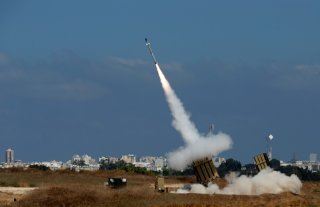Here's What Makes the Iron Dome So Incredible
2,500 missiles stopped over ten years is an impressive resume.
Here's What You Need to Remember: The Iron Dome isn’t even at the apex of its potential yet, undergoing frequent upgrades through the years. It’s likely that we’ll see the Iron Dome achieve a near 100% success rate in our lifetime.
Imagine 2,500 missiles over the course of ten years hurtling toward your city. It’s a terrifying thought right? Israel’s Iron Dome has virtually eliminated that fear with its advanced and futuristic defense technology.
The mobile all-weather missile defense system is a riveting piece of technology that shoots missiles right out of the sky, and its results speak for themselves.
The Iron Dome was developed in response to Hezbollah’s attacks in the 1990s. Despite defense officials stating that the idea of short-range missile defense was “doomed to fail,” Israel and the United States persisted and began developing a system in 2004. After years of research and testing, Israel rolled out the Iron Dome which intercepted its first missile in April of 2011. The next year, it was reported that the Iron Dome intercepted over 300 missiles with an astounding success rate of 90%. In recent years Israeli officials have stated that the Iron Dome has an efficiency of 95%, though some believe that this number is being inflated for political reasons. Still, the work that the Iron Dome has done can’t be denied.
The technology involved is sophisticated, fascinating, and seems pulled right out of a Tom Clancy novel. The most important aspect is detecting missiles. The detection technology is the first tier of three. A radar detects the presence of a missile over or near a given area. Then that information is relayed to a control center computer where the missile trajectory is calculated. If the system determines the missile will not hit a populated area, the missile is allowed to land, but if the missile is a threat countermeasures are put into action.
These countermeasures are called Tamir Interceptor Missiles. They target threats in the sky and destroy them before they can detonate their payload. Unlike most ground missile batteries, the mobile missile units are scattered around the country allowing coverage of about 70 kilometers of urban development. It’s important to note that these are mobile units as well and can be packed up and moved as needed in only a few hours.
Israel’s Iron Dome has successfully defended the country from over 2,500 missiles over the course of ten years. Even at ranges of forty-five miles, the Iron Dome can intercept threats creating a safer way of life for Israeli residents. Some have even taken the Midwestern approach to tornadoes and started “missile watching” where they’ll stare at the sky and even record the Iron Dome at work, turning lethal missiles into plumes of smoke.
The Iron Dome isn’t even at the apex of its potential yet, undergoing frequent upgrades through the years. It’s likely that we’ll see the Iron Dome achieve a near 100% success rate in our lifetime.
This technology is revolutionary and might be paving the way to safer cities in war-torn areas of the world. Some countries like the United States have even been developing their own defense systems. For instance, America and Israeli are working together on David’s Sling. Other countries like India, Romania, and South Korea are looking to outright purchase Iron Dome units.
Richard Douglas writes on firearms, defense and security issues. He is the founder and editor of Scopes Field, and a columnist at The National Interest, 1945, Daily Caller and other publications.
This article was published earlier this year and is being reposted due to reader interest.
Image: Reuters.

